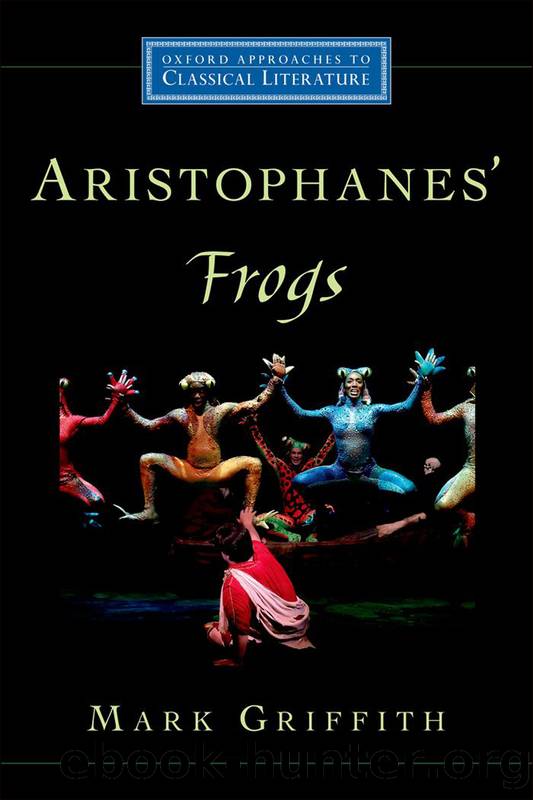Aristophanes' Frogs by Mark Griffith;

Author:Mark Griffith;
Language: eng
Format: epub
Publisher: OUP Premium
Published: 2013-05-14T16:00:00+00:00
Figure 5â1. Two examples of Dionysian music, as represented in Athenian vase-painting of the fifth century.
(a) Dionysus plays a barbitos (lyre) while two satyrs dance and play krotala (castanets).
Interior of Red-figure kylix-cup by the Brygos Painter, ca. 480 BCE (ARV2 371,14: Cab. Méd. Inv. 575). Drawing by Elizabeth Wahle.
Figure 5â1. (b) A young man plays the auloi (double-pipes), presumably at a symposium, while a woman dances with krotala (castanets).
Red-figure Athenian kylix-cup by Epictetus (ARV2 72,16), ca. 500 BCE (London E38, 1843,1103.9). Photo courtesy of the Trustees of the British Museum.
But whichever interpretation we give to this line, and whether we take the Muse to be old or young, attractive or hideous, it is in any case crucial that she is female. The notion of the âartâ of tragedy, or a âMuse,â or âMusicâ itself, being a feminine companion or sexual plaything of the male poet, thus both a source of his inspiration and the object of his controlâpossibly even a sex object to be pandered to othersâruns deep in this play, and is a recurrent theme in Greek (and Roman) culture at large. (It was clearly a major theme also of Cratinusâ Pytinê [421 BCE]; see chapter 1.) By contrast, no comments or innuendoes are made in Frogs about Aeschylusâ wife or family (or any mistress): the legitimacy of his Athenianness and of his poetry is taken for granted. The notion that Euripides had a ménage à trois with his composer, Cephisophon, consorted with a foreign dancing-Muse, and presented whorish heroines on the stage in his tragedies calls into question both his moral and his political respectability, just as such accusations do in the case of (allegedly) foreign-born populist politicians such as Cleophon (680â82). This happens again at the end of the song of the âMuse,â as Aeschylus points to the âfootâ or âlegâ (1322â23 poda) of the dancing Muse, and scoffs at Euripides, âWhen you are composing/making (poiôn) stuff like that,/ do you have the nerve to find fault with my songs/limbs (melê),/ as you make your songs/ move your limbs (melopoiôn) in (or âwithâ) the Twelve Tricks of Cyrene?â Cyrene was the name of a famous, expensive courtesan in late fifth-century Athens, whose beauty and âmoves/tricksâ were frequently alluded to by Aristophanes and others. (Cyrene was also the name of a Greek city in Libya, exotic and wealthy.)
In a similar comic turn, Aristophanesâ contemporary and rival, Pherecrates, in his Cheiron (fr. 155, a substantial fragment of which survives in quotation), had introduced Music (Mousikê) as a character onstage who complains that she has been sexually molested by a series of leading practitioners of the New Music. She refers first to the fast-and-loose switching back and forth of lyric modes by the dithyrambist Cinesias, as he âcomposed ill-tuned bendings in his strophes ⦠so that you couldnât tell his left from his right,â and then Phrynes âbending and twisting ⦠with twelve tunings (harmonias) on five strings,â and finally Timotheus, who âcompletely ruined [her] with his twelve stringsââa striking
Download
This site does not store any files on its server. We only index and link to content provided by other sites. Please contact the content providers to delete copyright contents if any and email us, we'll remove relevant links or contents immediately.
Cecilia; Or, Memoirs of an Heiress — Volume 3 by Fanny Burney(31455)
Cecilia; Or, Memoirs of an Heiress — Volume 2 by Fanny Burney(31406)
Dialogue by Robert McKee(4160)
The 101 Dalmatians by Dodie Smith(3298)
Bound by Hatred (The Singham Bloodlines Book 2) by MV Kasi(2951)
Harry Potter and the Cursed Child - Parts One and Two by John Tiffany(2921)
The Art of Dramatic Writing: Its Basis in the Creative Interpretation of Human Motives by Egri Lajos(2857)
The Beautiful Boys: A High School NA Reverse Harem Paranormal Bully Romance (Shadowlight Academy Book 1) by Gow Kailin(2728)
Angels in America by Tony Kushner(2390)
Carrie's War by Nina Bawden(2354)
A Clockwork Orange by Anthony Burgess(2321)
Unlaced by Jaci Burton & Jasmine Haynes & Joey W. Hill & Denise Rossetti(2251)
The Femme Playlist & I Cannot Lie to the Stars That Made Me by Catherine Hernandez(2170)
Drama by John Lithgow(2116)
Open Book by Jessica Simpson(2112)
Outside Woman (BWWM Amish Romance) by Stacy-Deanne(1968)
Terrorist Cop by Mordecai Dzikansky & ROBERT SLATER(1962)
Yerma by Federico García Lorca(1921)
Leo's Desire by Sundari Venkatraman(1813)
